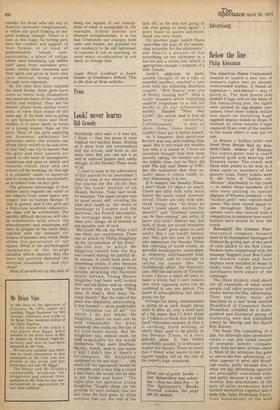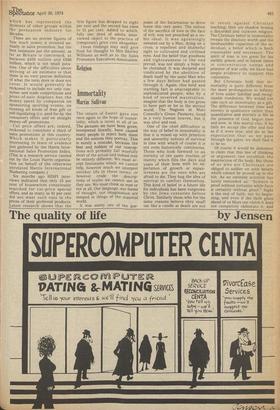Advertising
Below the line
Philip Kleinman
The American Hanes Corporation wanted to launch a new line of women's tights into an already overcrowded market. It found an ingenious — and absurd — way of doing it. The new brand was dubbed L'eggs and on the basis of this excruciating pun, the tights were packed in egg-shaped containers. Over three million dollars was spent on installing huge eggshell display stands in shops. It worked. In three months L'eggs captured 35 per cent of the market in the areas where it was put on sale.
In Britain a 'bullion train' was hired from British Rail by Kimberly-Clark, makers of Kleenex. The centre-piece was a coach painted gold and bearing the Kleenex name. The coach was filled with prizes to be won in a draw open to members of the grocery trade. Entry tickets were in the form of "bullion certificates" distributed' to the trade — or rather those members of it who were putting on special displays of Kleenex products — by "bullion girls" who visited their stores. The train visited major cities throughout Britain. Consumers were also enticed with a competition to estimate how many bullion bars would fit into the coach.
Beiersdorf, the German Pharmaceutical company, boosted sales of its Hansaplast bandages in Holland by giving part of the price of each packet to the Red Cross. Packets were overprinted with the message 'Support your Red Cross' and window cards and floor displays were installed in shops to make sure that all potential purchasers were aware of the campaign.
The three projects cited above are all examples of what some people call sales promotion and others below-the-line advertising. They and many more are described in a new book entitled Handbook of Consumer Sales Promotion, compiled by a distinguished pan-European group of marketing men and published jointly by Harrap and the Dutch firm Kluwer.
The book fills something of a gap, for although sales promotion covers a vast and varied amount of economic activity comparatively little has been written about it. Most of the attention has gone to above-the-line advertising, i.e. what appears in print and broadcast media, partly because that is what the big advertising agencies are principally concerned with, and partly because it is only very recently that practitioners of the arts of sales promotion have banded themselves together into a body (the Sales Promotion Executives Association) of the kind
Which has represented the interests of other groups within the persuasion industry for decades.
There are no precise figures of how much money is invested annually in sales promotion, but the best estimates put the amount, as far as Britain is concerned, at between £450 million and £500 million, which is not small potatoes. One of the difficulties about arriving at an estimate is that there is no very precise definition of what the term does or does not cover. It would generally be reckoned to include not only consumer and trade competitions and Point-of-sale displays but the money spent by companies on sponsoring sporting events, on running all kinds of free gift or Self-liquidating (i.e. paid for by the consumer) offers and on straight money-off promotions.
Cut price offers are, indeed, reckoned to constitute a third of sales promotions in this country. Which makes it particularly interesting to learn of evidence Just gathered by the Harris International Sales Promotion Index. (This is a research service carried out by the Louis Harris organisation on behalf of the otherwise unrelated Harris International Marketing company.) Six months ago HISPI interviews indicated that only 15 per cent of housewives consciously searched for cut-price special offers, and as many as 41 per cent did not want such cuts in the prices of their preferred products. Latest research shows that the first figure has dropped to eight per cent and the second has risen to 51 per cent. Added to which, fully one third of adults interviewed object to the practice of (temporary) price cuts altogether.
these findings may well give food for thought to Mrs Shirley Williams as well as to the Sales Promotion Executives Association.



































 Previous page
Previous page